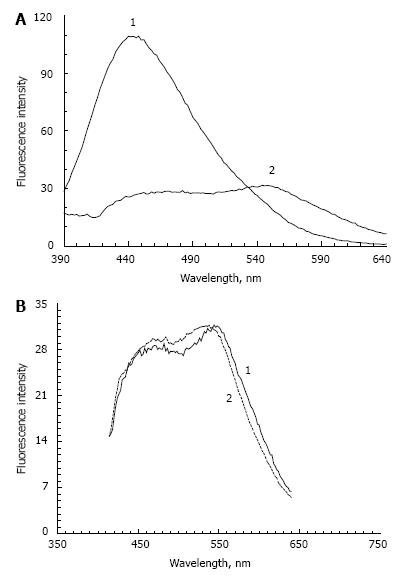Copyright
©The Author(s) 2016.
World J Exp Med. Nov 20, 2016; 6(4): 63-71
Published online Nov 20, 2016. doi: 10.5493/wjem.v6.i4.63
Published online Nov 20, 2016. doi: 10.5493/wjem.v6.i4.63
Figure 3 Production of model lipofuscin in the reaction between modified photoreceptor outer segments and bisretinoid A2E.
A: A2E binding by modified photoreceptor outer segments leads to a change in their fluorescence characteristics: curve 1 - POS modified oxidized prior to incubation with A2E; curve 2 - modified POS containing A2E (LPO - lipofuscin); B: Comparison of fluorescence characteristics of the model lipofuscin (LPO) and natural lipofuscin granules from human RPE: curve 1 (solid line) - LPO; curve 2 (dotted line) - lipofuscin granules from human RPE. Model lipofuscin preparation is described in materials and methods, excitation wavelength - 365 nm. POS: Photoreceptor outer segments; RPE: Retinal pigment epithelium.
- Citation: Dontsov A, Koromyslova A, Ostrovsky M, Sakina N. Lipofuscins prepared by modification of photoreceptor cells via glycation or lipid peroxidation show the similar phototoxicity. World J Exp Med 2016; 6(4): 63-71
- URL: https://www.wjgnet.com/2220-315X/full/v6/i4/63.htm
- DOI: https://dx.doi.org/10.5493/wjem.v6.i4.63









